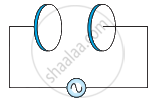Advertisements
Advertisements
Question
A parallel-plate capacitor of plate-area A and plate separation d is joined to a battery of emf ε and internal resistance R at t = 0. Consider a plane surface of area A/2, parallel to the plates and situated symmetrically between them. Find the displacement current through this surface as a function of time.
Solution
Electric field strength for a parallel plate capacitor,
`E = Q/(∈_0A)`
Electric flux linked with the area,
`phi_E = EA = Q/(∈_0A) xx A/2 = Q/(2∈_0)`
Displacement current ,
`I_d = ∈_0 (dphi_E)/dt = ∈_0 d/dt(Q/(∈_0 2))`
`I_d = 1/2((dQ)/dt)` ....(i)
Charge on the capacitor as a function of time during charging,
`Q = εC[1 - e^(-t"/"RC)]`:
Putting this in equation (i), we get :
`I_d = 1/2 εC d/dt(1 - e^(-t"/"RC))`
`I_d = 1/2 εC(-e^(-t"/"RC)) xx (-1/(RC))`
`C = (A∈_0)/d`
⇒ `I_d = ε/(2R) xx e^(-(td)/(ε_0AR))`
APPEARS IN
RELATED QUESTIONS
Figure shows a capacitor made of two circular plates each of radius 12 cm, and separated by 5.0 cm. The capacitor is being charged by an external source (not shown in the figure). The charging current is constant and equal to 0.15 A.
- Calculate the capacitance and the rate of charge of the potential difference between the plates.
- Obtain the displacement current across the plates.
- Is Kirchhoff’s first rule (junction rule) valid at each plate of the capacitor? Explain.

A parallel plate capacitor (Figure) made of circular plates each of radius R = 6.0 cm has a capacitance C = 100 pF. The capacitor is connected to a 230 V ac supply with a (angular) frequency of 300 rad s−1.
- What is the rms value of the conduction current?
- Is the conduction current equal to the displacement current?
- Determine the amplitude of B at a point 3.0 cm from the axis between the plates.

The charging current for a capacitor is 0.25 A. What is the displacement current across its plates?
A capacitor has been charged by a dc source. What are the magnitude of conduction and displacement current, when it is fully charged?
A spring balance has a scale that reads 0 to 50 kg. The length of the scale is 20 cm. A body suspended from this spring, when displaced and released, oscillates with a period of 0.60 s. What is the weight of the body?
A cylinder of radius R, length Land density p floats upright in a fluid of density p0. The cylinder is given a gentle downward push as a result of which there is a vertical displacement of size x; it is then released; the time period of resulting (undampe (D) oscillations is ______.
The displacement of a particle from its mean position is given by x = 4 sin (10πt + 1.5π) cos (10πt + 1.5π). The motion of the particle is
Displacement current goes through the gap between the plantes of a capacitors. When the charge of the capacitor:-
According to Maxwell's hypothesis, a changing electric field gives rise to ______.
A capacitor of capacitance ‘C’, is connected across an ac source of voltage V, given by
V = V0sinωt
The displacement current between the plates of the capacitor would then be given by:
The charge on a parallel plate capacitor varies as q = q0 cos 2πνt. The plates are very large and close together (area = A, separation = d). Neglecting the edge effects, find the displacement current through the capacitor?
A variable frequency a.c source is connected to a capacitor. How will the displacement current change with decrease in frequency?
Show that the magnetic field B at a point in between the plates of a parallel-plate capacitor during charging is `(ε_0mu_r)/2 (dE)/(dt)` (symbols having usual meaning).
Sea water at frequency ν = 4 × 108 Hz has permittivity ε ≈ 80 εo, permeability µ ≈ µo and resistivity ρ = 0.25 Ω–m. Imagine a parallel plate capacitor immersed in seawater and driven by an alternating voltage source V(t) = Vo sin (2πνt). What fraction of the conduction current density is the displacement current density?
A long straight cable of length `l` is placed symmetrically along z-axis and has radius a(<< l). The cable consists of a thin wire and a co-axial conducting tube. An alternating current I(t) = I0 sin (2πνt) flows down the central thin wire and returns along the co-axial conducting tube. The induced electric field at a distance s from the wire inside the cable is E(s,t) = µ0I0ν cos (2πνt) In `(s/a)hatk`.
- Calculate the displacement current density inside the cable.
- Integrate the displacement current density across the cross-section of the cable to find the total displacement current Id.
- Compare the conduction current I0 with the displacement current `I_0^d`.
AC voltage V(t) = 20 sinωt of frequency 50 Hz is applied to a parallel plate capacitor. The separation between the plates is 2 mm and the area is 1 m2. The amplitude of the oscillating displacement current for the applied AC voltage is ______.
[take ε0 = 8.85 × 10-12 F/m]
A parallel plate capacitor is charged to 100 × 10-6 C. Due to radiations, falling from a radiating source, the plate loses charge at the rate of 2 × 10-7 Cs-1. The magnitude of displacement current is ______.
